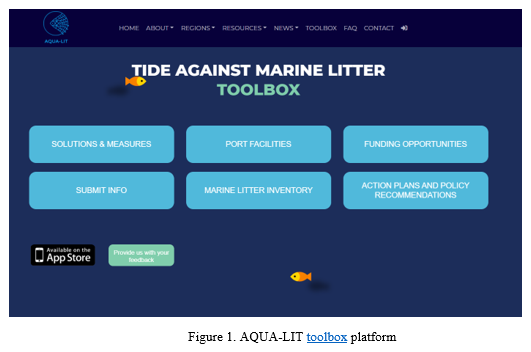TOOLBOX FOR GOOD MARINE LITTER MANAGEMENT IN THE AQUACULTURE SECTOR
Introduction
Ocean based sources account for 20 % of the plastic pollution such as overboard discharges from ships and abandoned, lost or otherwise discarded fishing and aquaculture gear (ALDFG). Considering that ALDFG is estimated to compose less than 10 percent of total marine debris by volume at a global scale, and even though the overall contribution to ALDFG from aquaculture is probably limited due to its static nature; intensive aquaculture still has the potential for lost cages, longlines, poles and other floating and fixed items to escape the system, being transformed in sources of plastic debris.
Considering that Aquaculture is the fastest growing food-producing sector, accounting already for 50 percent of the world’s fish that is used for food , and with an European goal of doubling its production by 2030, AQUA-LIT’s goal is to avoid that an increase in aquaculture production imply an increase in marine litter input. Thus, the project main objective was to provide the aquaculture sector with a Toolbox that can provide existing, upcoming and already implemented tools, case studies, best practices, a database and links between stakeholders for addressing the 3 main components of marine littering from aquaculture activities: prevention & reduction, monitoring & quantification, and removal & recycling.
Metholodgy
T he AQUA-LIT Toolbox is the result of the compilation of available literature and litter databases (e.g. OSPAR, HELCOM, Marine Litter Watch) , the information provided by the stakeholders in the frame of the project, the state of play regarding the aquaculture marine litter management in 2019 and 2020 and the input of the experts that have been part of or have work closely together with the AQUA-LIT team. The assessment is based on the proposed tools and governance approaches developed during the AQUA-LIT Learning Labs in the Mediterranean Sea, North Sea and Baltic Sea regions, and at the same time built on AQUA-LIT’s comprehensive review including: D3.5 Learning Labs outcomes (portfolio of best practice fact sheets).
Results
The toolbox accessible online and as an App, provides more than 400 of ideas and solutions to tackle marine litter that can be filtered by stage (prevention and reduction, monitoring and quantification , removal and recycling), by type of aquaculture (shellfish, finfish, seaweed), by sea basin (Baltic Sea, Mediterranean Sea, North Sea), and by category of measure (support, knowledge, responsibility, legislation).
Furthermore, the toolbox also includes information on which ports have the facilities to receive waste, a database of funding opportunities to create a project on marine litter, as well as a marine litter inventory that provides an overview of the available knowledge on marine litter originating from the aquaculture sector, a set of policy recommendations for the EU and lastly, specific action plans for outermost regions.
Conclusions
The AQUA-LIT t oolbox aims to be considered the most important knowledge repository for aquaculture-mairne litter related information across Europe and the starting point for the development of new European policies regarding the marine litter coming from aquaculture.
T his Toolbox can be used as a guidance for the management of the marine litter that comes from aquaculture in the European context. The targeted audience includes aquaculture farmers; professional clusters, associations and platform representatives; policy makers; port authorities; aquaculture gear and equipment producers; engineering, system design and construction companies; plastic manufacturers; waste managers; researchers; environmental and social consultancies; NGOs; classification and certification bodies; communicators and any other interested person.
